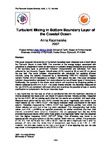Turbulent Mixing in Bottom Boundary Layer of the Coastal Ocean
| dc.contributor.author | Kaczmarska, A. | |
| dc.date.accessioned | 2018-11-08T13:09:51Z | |
| dc.date.accessioned | 2018-11-19T12:21:53Z | |
| dc.date.available | 2018-11-08T13:09:51Z | |
| dc.date.available | 2018-11-19T12:21:53Z | |
| dc.date.issued | 2008 | |
| dc.identifier.citation |
Kaczmarska, A. (2008) 'Turbulent Mixing in Bottom Boundary Layer of the Coastal Ocean', The Plymouth Student Scientist, 1(1), p. 162-228 | en_US |
| dc.identifier.issn | 1754-2383 | |
| dc.identifier.uri | http://hdl.handle.net/10026.1/12807 | |
| dc.description.abstract |
This paper analyses the evolution of the bottom boundary layer observed over a flood tide in the Plymouth Sound in June 2006. The overview of the energy budget associated with turbulence is presented in which an estimation of turbulent energy dissipation and production in the boundary layer is performed. Turbulent characteristics are calculated from data collected by two Acoustic Doppler Velocimeters (ADV) located at 69 cm and 52 cm above the sea bed. The same turbulent characteristics are calculated, but applying different methods, using the velocity measured by a downlooking 1200 kHz Acoustics Doppler Current Profiler (ADCP) installed at a height 1.36m above the bed. The study compares turbulent characteristics calculated from data collected by two different types of instruments. Additionally, the currents in the whole water column are examined by analysing profiles of velocity collected by 600 kHz ADCP. The study checks whether the velocities measured by the two ADCPs are consistent with each other and examines the possible effects of density stratification on turbulence in the bottom boundary layer. It was found that the flow was an effect of semidiurnal tide with the maximum velocities of 22cm/s observed two hours after Low Water 4m above the bed. Velocity profiles, measured by the two ADCP, did not overlap each other but the results are consistent with each other. Measurements performed by both ADVs showed the same magnitudes and trends in the mean velocity as the 1.2MHz ADCP. The results indicated weak stratification in the water column. Velocities measured by 1.2MHz ADCP had logarithmic profiles from which the friction velocity (u*) and bed stress (τb) were calculated. The characteristics had similar values (u*<1cm/s, τb<0.09Pa) as reported previously for similar conditions (flat bed, tidal channel, unstratified water column). Dissipation rate (ε) calculated from the two ADVs provided inaccurate results which were three orders of a magnitude higher than that obtained from the higher frequency ADCP (10-8-10-6 W/kg). That difference was found to be associated with the assumptions of the first method, which were not fulfilled. The production of TKE (P), from ADVs and the 1.2MHz ADCP, had the same magnitude than ε and the average ε/P ratio, over the whole time of deployment, was found to be 1.45 +/- 1.07. However, the ratio was biased by the high ε during run 2. After rejecting that run the ratio was closer to the expected value of unity: 0.78 +/- 0.36. | en_US |
| dc.language.iso | en | en_US |
| dc.publisher | University of Plymouth | |
| dc.rights | Attribution 3.0 United States | * |
| dc.rights.uri | http://creativecommons.org/licenses/by/3.0/us/ | * |
| dc.title | Turbulent Mixing in Bottom Boundary Layer of the Coastal Ocean | en_US |
| dc.type | Article | |
| plymouth.issue | 1 | |
| plymouth.volume | 1 | |
| plymouth.journal | The Plymouth Student Scientist |



